
The Scales Mound Historic District is a historic district in the small Illinois village of Scales Mound. The district encompasses the entire corporate limit of the village and has more than 200 properties within its boundaries. The district was added to the U.S. National Register of Historic Places in 1990.

The Mrs. A. W. Gridley House is a Frank Lloyd Wright designed Prairie School home in Batavia, Illinois.

The Masonic Temple in Maywood, Illinois is a building from 1917. It was designed with Prairie School architectural elements by architect Eben Ezra Roberts.
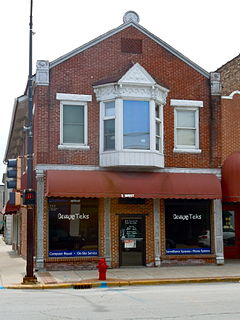
The Stolp Woolen Mill Store was built in 1860. It is located on Stolp Island in Aurora, Illinois. It was listed on the National Register of Historic Places in 1983. It is also a contributing building in the Stolp Island Historic District.

The Simsbury Bank and Trust Company Building, also known as the former Town Hall Building, is a historic commercial and civic building at 760 Hopmeadow Street in Simsbury, Connecticut. Built in 1917, it is a prominent local example of Colonial Revival architecture with Beaux Arts features. It originally housed the town's first bank, and was its town hall between 1969 and 1984. The building was listed on the National Register of Historic Places in 1986.

Central Office Building is a historic building located in downtown Davenport, Iowa, United States. It has been individually listed on the National Register of Historic Places since 1983. In 2020 it was included as a contributing property in the Davenport Downtown Commercial Historic District. It is located in the center of a block with other historic structures. It now houses loft apartments.

First Congregational Church of Austin, also known as Greater Holy Temple of God in Christ, is a historic church at 5701 West Midway Place in Chicago, Illinois. The church was built in 1905 for a Congregational assembly; it was later used by Seventh-Day Adventist, Roman Catholic, and Church of God in Christ congregations. A Chicago building permit was issued on August 15, 1905 according to the Chicago Tribune of August 16, 1905. Architect William Eugene Drummond, a student of Louis Sullivan and a sometime employee of Frank Lloyd Wright, designed the church in the Prairie School style; it is an unusual example of a Prairie School church and influenced Wright's Unity Temple which was designed after the original church burned on June 4, 1905. The one-story building consists of a tall central section with massive piers and a smaller section to either side. The entrance is recessed in the base of the central section; the doorway features lintels and posts that continue the building's rectilinear emphasis. Leaded glass windows are recessed in the spaces between the central section's piers.

The Illinois Traction Building, located at 41 E. University Ave. in Champaign, Illinois, was the headquarters of the Illinois Traction System, an interurban railroad serving Central Illinois. Built in 1913, the building held the railway's offices and served as the Champaign interurban station until 1936; it later housed the offices of the Illinois Power Company, which descended from the Illinois Traction System. Architect Joseph Royer planned the building in a contemporary commercial design. The building was added to the National Register of Historic Places on September 20, 2006.

The Henry H. Page House is a historic house located at 221 North Union Street in Vermont, Illinois. Horse breeder Henry H. Page had the house built for his family in 1912–13. The house's design reflects a contemporary trend which architectural historian Alan Gowans described as Picturesque Eclectic; while its form distinctly fits a recognizable style, in its case the American Foursquare, its ornamentation borrows from multiple different styles. The large front gable dormer, which includes a horseshoe arch opening and decorated spandrels, is a Queen Anne feature. The cornice features both bracketing and stickwork, decorative elements of the Italianate and Stick styles respectively. The brick piers supporting the front porch come from the American Craftsman style, while the leaded windows are Classical Revival elements.
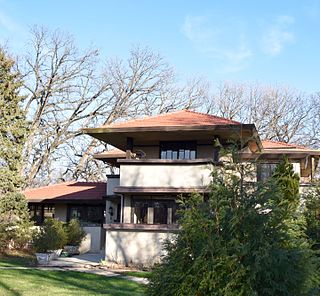
The Richard Cluever House is a historic house at 601 1st Avenue in Maywood, Illinois. Built in 1913–14, the house was designed by noted Prairie School architect John S. Van Bergen. Van Bergen worked for Frank Lloyd Wright before starting his own practice, and like many of his early designs, the Cluever House closely resembles Wright's work. The house features many verandas and balconies and rows of casement windows, providing views of the nearby Des Plaines River. Landscape architect Jens Jensen designed the house's surroundings, which include a garden between the house and the river.

The Mrs. Henry F. Akin House is a historic house at 901 S. 8th Avenue in Maywood, Illinois. The house was built circa 1910 for Elizabeth R. Akin, the wife of former Maywood mayor Henry F. Akin. Tallmadge and Watson, Chicago-area architects who were pioneers of the Prairie School style, designed the home. The one-story bungalow features a stucco exterior, wood banding which forms geometric shapes, casement windows, and overhanging eaves, all typical elements of early Prairie works. The house is one of three in Maywood designed by prominent Prairie School architects and the only bungalow of the three.

The Timothy J. Lynch House is a historic house at 416 N. 4th Avenue in Maywood, Illinois. The house, a large Chicago bungalow, was built in 1927. While thousands of bungalows were built in the Chicago area in the 1920s, including many others in Maywood, the Lynch House is unusual both for its size and its level of ornamentation. The house's design includes a main entrance with arched sidelights, round arched windows in a large front bay, patterned stained glass panels, and a green tile roof. Like many Chicago bungalows, the design features several elements of Prairie School architecture, such as the geometric designs in its stained glass windows, overhanging eaves, and wood trim on every door and window.
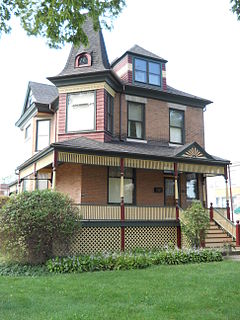
The Harry H. Nichols House is a historic house at 216 S. 4th Avenue in Maywood, Illinois. The house was built in 1894 for Harry H. Nichols, the former postmaster of Maywood and the son of village founder William T. Nichols. It was designed in the Queen Anne style, which was popular in the late nineteenth century; along with the Jacob Bohlander House, it is one of two large, formal Queen Anne homes in Maywood. The house's design includes a wraparound front porch with a balustrade, a gable with a sunburst design above the entrance, a projecting gabled bay on its south side, and a rectangular tower at its southeast corner. Neoclassical elements such as urns, columns, and cornices adorn its interior; these were most likely inspired by the architecture of the recent Columbian Exposition.
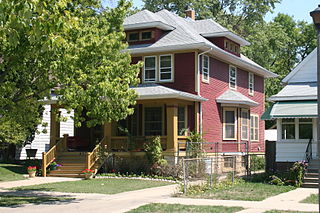
The William and Caroline Gibbs House is a historic house at 515 N. 3rd Avenue in Maywood, Illinois. The American Foursquare house was built in 1907. The house has a standard Foursquare layout with a square shape, a pyramidal roof with dormers, and a front porch. In keeping with its style, its interior has a functional layout with a central staircase, an easily accessible kitchen, and built-in furniture. As was common in Foursquare homes, the house has simple geometric detailing inspired by the Craftsman movement, such as wood trim, leadlight windows, and square columns.

The Joseph P. O. Sullivan House is a historic house at 142 S. 17th Avenue in Maywood, Illinois. The house was built circa 1895 by the Proviso Land Association for Joseph P. O. Sullivan. The Proviso Land Association was the second land developer to invest in Maywood, after the Maywood Company; most homes built by the Association have been demolished, making the Sullivan House a rare example of their work. Like many of the Association's homes, the Sullivan House has an American Foursquare design. The house has a rectangular two-story layout with a front porch, a projecting bay on one side, a hip roof, and a dormer with a classical Palladian window.

The William Frangenheim House is a historic house at 410 N. 3rd Avenue in Maywood, Illinois. The house was built in 1906 on a plot previously owned by the Maywood Company, the development company that planned Maywood. It is designed in the American Foursquare style, a vernacular style which was used in many Maywood houses of the period. Like most Foursquare homes, the house has a square two-story layout with a front porch and a hip roof with a dormer. In keeping with its utilitarian style, the house has little external decoration; its interior features Craftsman-inspired wood trim, though it is still relatively plain.

The Caroline Grow House is a historic house at 603 N. 6th Avenue in Maywood, Illinois. The house was built circa 1902 by Caroline Grow, whose late husband David bought the house's plot in 1875. It has an American Foursquare design, a utilitarian style which was popular in the early twentieth century. The 2+1⁄2-story house has a rectangular form with a front porch supported by four columns and a hip roof with a central dormer, a typical layout for a Foursquare home. The design also includes Neoclassical details such as the Doric capitals on the porch's columns; these were common in Chicago-area architecture after the 1893 Columbian Exposition popularized the style.

The Caroline Millward House is a historic house at 502 N. 5th Avenue in Maywood, Illinois. The house was built circa 1906 for owner Caroline Millward. It has an American Foursquare design, a simplified style popular in the early twentieth century, with Prairie School elements. The 2+1⁄2-story house has a typical Foursquare layout, with a rectangular shape, a front porch supported by wide piers, a glazed porch on one side, and a hip roof with a front-facing dormer. The horizontal emphasis of the design is typical of the Prairie School, as are its bands of windows, wood trim, overhanging eaves, and built-in furniture.
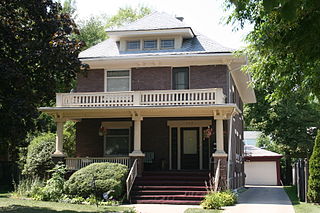
The Albert Soffel House is a historic house at 508 N. 5th Avenue in Maywood, Illinois. The two flat house was built in 1905 for original owner Albert Soffel. It has an American Foursquare design, a utilitarian style popular in the early twentieth century, with Arts and Crafts and Neoclassical ornamentation. The house has a typical Foursquare plan with a rectangular layout, a front porch supported by three columns, and a hip roof with a dormer. Its decorative features include Ionic styling on the porch columns, dentillation and brackets on the porch roof, additional bracketing along its eaves, and multiple stained glass windows.
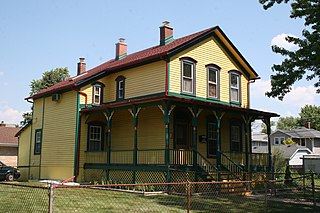
The Jennie S. Thompkins House is a historic house at 503 N. 4th Avenue in Maywood, Illinois. The house was built circa 1872 for Jennie S. Thompkins and her husband; they purchased its plot from the Maywood Company, the original developers of Maywood. It has a gable front design, a vernacular style commonly found in working-class Chicago homes of the period. While the gable front style was also common in Maywood, the house is an especially well-preserved example of the style, as most others have since been modified or sided. The design includes a three-bay facade with segmental arched windows and a wraparound front porch that features brackets, turned posts, and a balustrade.























